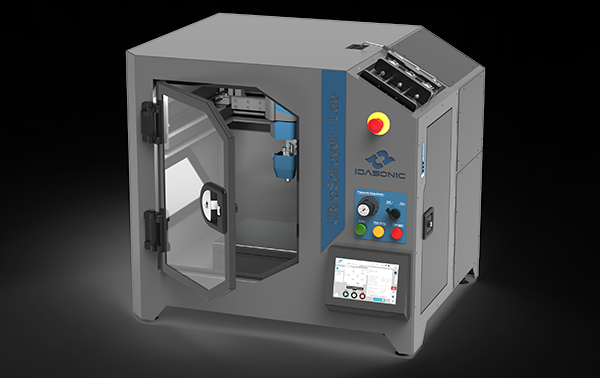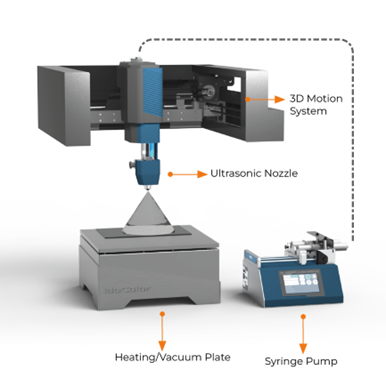
In the world of advanced material technologies, the precision and quality of surface coatings directly affect the performance of the final product. The Ultrasonic Spray Pyrolysis (USP) technique stands out as a pioneering method offering high performance and homogeneity in this process. In this newsletter, we will explore the process of thin film coating with the USP technique and how Idasonic sets new standards with the Ultrasprayer, IdaFlow Syringe Pump and IdaMist Atomizer.
✨Let’s take a step-by-step look at the thin film coating process with the UltraSprayer®:
The thin film coating process begins with the preparation of a precursor solution containing the appropriate chemical components to form a thin film on a given surface. This solution usually contains metal salts, organic or inorganic components and is formulated according to the properties of the targeted thin film. The properties of the solution (viscosity, concentration, etc.) are critical to the quality of the thin film to be obtained.
The prepared precursor solution is placed into the IdaFlow syringe pump for precise dosing. The syringe pump ensures a controlled delivery of the solution to the ultrasonic atomizer. This step ensures that the droplet size is consistent during the atomization process by keeping the flow rate of the solution constant. The syringe pump is typically used in microfluidic systems and makes it possible to continuously feed the solution even at very low flow rates.
The prepared precursor solution is converted into fine droplets via the IdaMist ultrasonic atomizer. Our atomizer and ultrasonic generator system produces high-frequency vibrations with the help of a piezoelectric transducer, atomizing the precursor solution into fine droplets. These droplets are extremely small and homogeneous, which makes it possible to evenly distribute the coating over the surface. The size of the droplets varies depending on the ultrasonic frequency and the properties of the solution. IdaMist offers solutions to these demands with product alternatives at different frequencies.
The atomized fine droplets are directed onto the surface to be coated with a carrier gas. This carrier gas is usually an inert gas such as nitrogen or argon. The gas flow controls the speed and movement of the droplets, ensuring that they reach the target surface uniformly.
Once the droplets reach the surface, an immediate evaporation process starts on the surface, which is kept at a high temperature by IdaCalor. This high temperature created on the surface leads to the rapid evaporation of the solvent contained in the droplets, allowing the remaining metal salts or other components to undergo thermal degradation. This degradation contributes to the formation of a thin and homogeneous film layer. One of the critical stages of the process is to ensure a uniform temperature distribution on the surface. IdaCalor is designed with advanced engineering and technology to ensure maximum uniformity of heat distribution on the surface, resulting in repeatable and consistent results in coating quality.
Film thickness can be optimized by precise control of critical parameters such as solution molarity and flow rate, carrier gas velocity, surface temperature, nozzle-to-substrate distance. The homogeneous distribution of droplets on the surface is one of the determining factors of coating quality. The UltraSprayer interface enables fine-tuning of these parameters, resulting in highly accurate and reproducible homogeneous coatings. This ensures consistency in coating thickness and distribution, maintaining the stability of the parameters throughout the process.
After the coating process is completed, the film formation is completed by cooling the surface in a controlled manner. The thin film formed usually exhibits a high level of homogeneity and smoothness depending on the experimental parameters. However, further characterization techniques are used to verify whether the coating has the targeted properties. These techniques include X-ray diffraction (XRD), X-ray photoelectron spectroscopy (XPS), scanning electron microscopy (SEM), and atomic force microscopy (AFM). These analyses are critical to evaluate in detail the crystallographic properties, surface chemistry, morphology, and surface roughness of the film structure.
As a result, the UltraSprayer Ultrasonic Spray pyrolysis technique offers an innovative approach in the field of advanced materials science and engineering, enabling the production of thin film coatings with high efficiency and precision.
IDASONIC’s advanced technology solutions for Ultrasonic Spray Coating optimize every step of the process, improving coating quality and maximizing repeatability. For more comprehensive technical information and examples of various application areas, please contact us today. 📞
🔍 In our next newsletter, we will take an in-depth look at the innovative applications of the UltraSprayer ultrasonic coating technique in different industries. Stay tuned to discover the potential of this technology and learn how it can make a difference in your industry.

Figure 1. Schematic diagram of UltraSprayer® Ultrasonic Spray Coating System.
For company news, product updates and releases, subscribe to our newsletter.
© 2016 IDASONIC: Ultrasonic Spray Coating & Electrospinning Systems
Privacy Policy – Terms and Conditions – Cookie Declaration